 W
WPac-Man is a maze arcade game developed and released by Namco in 1980. The original Japanese title of Puck Man was changed to Pac-Man for international releases as a preventative measure against defacement of the arcade machines by changing the P to an F. Outside Japan, the game was published by Midway Games as part of its licensing agreement with Namco America. The player controls Pac-Man, who must eat all the dots inside an enclosed maze while avoiding four colored ghosts. Eating large flashing dots called "energizers" causes the ghosts to turn blue, allowing Pac-Man to eat them for bonus points.
 W
WBlinky, Pinky, Inky and Clyde are the primary group of fictional ghosts who serve as the main antagonists in the Pac-Man franchise. Several different ghosts have appeared throughout the franchise, aside from the ones in the main aforementioned group.
 W
WPac-Man is a maze arcade game developed and released by Namco in 1980. The original Japanese title of Puck Man was changed to Pac-Man for international releases as a preventative measure against defacement of the arcade machines by changing the P to an F. Outside Japan, the game was published by Midway Games as part of its licensing agreement with Namco America. The player controls Pac-Man, who must eat all the dots inside an enclosed maze while avoiding four colored ghosts. Eating large flashing dots called "energizers" causes the ghosts to turn blue, allowing Pac-Man to eat them for bonus points.
 W
WToru Iwatani is a Japanese video game designer who spent much of his career working for Namco. He is best known as the creator of the arcade game Pac-Man (1980).
 W
WMr. & Mrs. Pac-Man released on May 1, 1982 is a pinball game designed by George Christian and released by Bally/Midway. It is based on Namco's classic Pac-Man series.
 W
WMs. Pac-Man Maze Madness is a 2000 maze chase video game developed and published by Namco for the PlayStation. It was later released for the Nintendo 64, Dreamcast, and Game Boy Advance. A remake of Ms. Pac-Man (1982), players control the titular character in her quest to stop a witch named Mesmerelda from stealing the Gems of Virtue. The game was well-received upon release, with critics applauding its simplicity and faithfulness to the arcade original.
 W
WMs. Pac-Man: Quest for the Golden Maze is a Microsoft Windows game published by Infogrames and released in 2001.
 W
WMasaya Nakamura was a Japanese businessman and the founder of Namco. He was the company's president up until 2002, where he took a ceremonial role in its management. Following the formation of Bandai Namco Holdings, Nakamura would retain an honorary position in the video game division, Bandai Namco Entertainment.
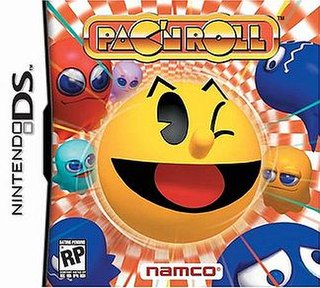 W
WPac 'n Roll is a video game developed by Namco for the Nintendo DS. The game stars a 3D Pac-Man as the user rolls him throughout the playing field using the touchscreen. The classic arcade Pac-Man game is also unlockable. It was later released for the Wii on the Namco Museum Remix and Namco Museum Megamix compilation games.
 W
WPac-Attack, also known as Pac-Panic, is a 1993 falling-tile puzzle video game developed and published by Namco for the Super Nintendo Entertainment System and Sega Genesis. Versions for the Game Boy, Game Gear and Philips CD-i were also released. The player is tasked with clearing out blocks and ghosts without them stacking to the top of the playfield — blocks can be cleared by matching them in horizontal rows, while ghosts can be cleared by placing down a Pac-Man piece that can eat them. It is the first game in the Pac-Man series to be released exclusively for home platforms.
 W
WPac-In-Time is a video game developed by Kalisto and published by Namco, featuring the popular arcade character Pac-Man. It was released in 1995 for MS-DOS, Macintosh, Super Nintendo Entertainment System and Game Boy. Versions for the Sega Genesis and Game Gear were planned before being cancelled.
 W
WPac-Man is a 1982 maze video game developed and published by Atari, Inc. under official license by Namco, and an adaptation of the 1980 hit arcade game of the same name. The player controls the title character, who attempts to consume all of the wafers while avoiding four ghosts that pursue him. Eating flashing wafers at the corners of the screen will cause the ghosts to turn blue and flee, allowing Pac-Man to eat them for bonus points.
 W
WPac-Man is a fictional character and the titular protagonist of the video game franchise of the same name. Created by Toru Iwatani, he first appeared in the arcade game Pac-Man (1980), and has since appeared in more than 30 licensed sequels and spin-offs for multiple platforms, and spawning mass amounts of merchandise in his image, including two television series and a hit single by Buckner & Garcia. He is the official mascot of Bandai Namco Entertainment.
 W
W"Pac-Man" is a song by British virtual band Gorillaz featuring American rapper Schoolboy Q. The track was released on 20 July 2020 as the sixth single for Gorillaz' seventh studio album, Song Machine, Season One: Strange Timez, and the fifth episode of the Song Machine project, a web series involving the ongoing release of various Gorillaz tracks featuring different guest musicians over the course of 2020.
 W
WPac-Man is a 1992 EP by electronic music artist Richard D. James, released under the pseudonym Power-Pill. The tracks on the album are remixes of the musical themes in the Pac-Man and New Rally-X arcade games.
 W
WPac-Man 2: The New Adventures, known in Japan as Hello! Pac-Man , is a side-scrolling adventure game in the Pac-Man series. Instead of being a maze game like the majority of its predecessors, Pac-Man 2 incorporates light point-and-click adventure game elements. It was produced and published by Namco for the Super Nintendo Entertainment System (SNES) and Sega Mega Drive/Genesis systems, and was released in 1994 by Namco. The game borrows its structure and certain elements from Pac-Land, and also appears to contain certain elements from the animated series, such as Pac-Man's family and a main villain commanding the ghosts.
 W
WThe Pac-Man 40th Anniversary is an ongoing celebration of the Pac-Man series of video games since the release of the arcade cabinet Pac-Man on May 22, 1980. Bandai Namco celebrated the anniversary through business ventures with video games, events, clothing and other forms of merchandise.
 W
WPac-Man 256 is an endless running video game developed by Hipster Whale and 3 Sprockets and published by Bandai Namco Entertainment. The game is part of the Pac-Man series and is inspired by the original Pac-Man game's infamous Level 256 glitch. The game was originally released as a free-to-play title for iOS and Android on August 20, 2015. A port of the game for PlayStation 4, Xbox One, and PC by Bandai Namco Studios Vancouver, featuring additional features, was released on June 21, 2016.
 W
WPac-Man All-Stars is a video game for Microsoft Windows developed by British studio Creature Labs and published by Infogrames in 2002. It is a multiplayer video game where players control their characters to run around in different arenas to collect the most dots.
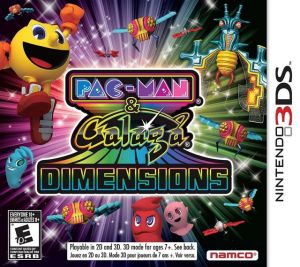 W
WPac-Man & Galaga Dimensions is a 2011 video game compilation developed and published for the Nintendo 3DS by Namco Bandai Games. It contains six games from the company's Pac-Man and Galaxian franchises—Pac-Man (1980), Galaga (1981), Pac-Man Championship Edition (2007), Galaga Legions (2008), Pac-Man Tilt, and Galaga 3D Impact, the last two being unique games created exclusively for this collection. Pac-Man Tilt is a platformer that supports the system's gyroscopic sensor, while Galaga 3D Impact is a first-person rail shooter. The collection also includes achievements, online leaderboards, and a trailer for the Pac-Man and the Ghostly Adventures television series.
 W
WPac-Man and the Ghostly Adventures, also known as Pac-World , is a computer-animated comedy-adventure children's television series featuring Namco's classic video game character Pac-Man. It is produced by 41 Entertainment, Arad Productions and Bandai Namco Entertainment for Tokyo MX, BS11 and Disney XD.
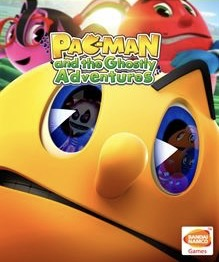 W
WPac-Man and the Ghostly Adventures, also known in Japan as Pac-World , is a 3D platform video game based on the TV series of the same name. The console and PC versions were developed by Monkey Bar Games and the 3DS version was developed by Inti Creates. Both versions were published by Namco Bandai Games.
 W
WPac-Man and the Ghostly Adventures 2, also known in Japan as Pac-World 2 , is a 2014 video game for the Wii U, Nintendo 3DS, Xbox 360 and PlayStation 3, released on October 14, 2014. It is the sequel to Pac-Man and the Ghostly Adventures.
 W
WPac-Man Championship Edition is a 2007 maze video game developed and published by Namco Bandai Games for the Xbox 360. It has since appeared on several other platforms, including the PlayStation 3, PlayStation Portable, and iOS. It is an HD reimagining of the original Pac-Man arcade game; players navigate Pac-Man through an enclosed maze, eating pellets and avoiding four ghosts that pursue him. Clearing an entire side of the maze of dots will cause a fruit item to appear, and eating it will cause a new maze to appear on the opposite side.
 W
WPac-Man Championship Edition 2 is a downloadable maze arcade game in the Pac-Man series which was released for PlayStation 4, Microsoft Windows, and Xbox One on September 15, 2016; an updated version featuring an exclusive 2-player co-op mode, Pac-Man Championship Edition 2 Plus, was released for Nintendo Switch on February 22, 2018. It was developed and published by Bandai Namco Entertainment, and is a direct sequel to Pac-Man Championship Edition, making it an indirect follow-up Pac-Man Championship Edition DX.
 W
WPac-Man Championship Edition DX is a 2010 maze video game developed and released by Namco Bandai Games for the Xbox 360 and PlayStation 3, later ported to Steam and iOS. It is the sequel to the 2007 game Pac-Man Championship Edition, which was the last game developed by series creator Toru Iwatani. The player controls Pac-Man as he must eat all of the dots in the maze while avoiding colored ghosts that pursue him. A bonus item will appear once the player has eaten all dots on one side of the maze, causing the layout to change. Several additions were made over the original, such as bombs that send all ghosts to the regeneration box and sleeping ghosts that will give chase should Pac-Man move past them.
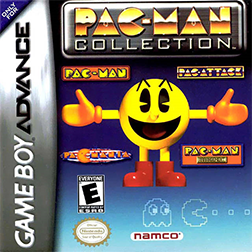 W
WPac-Man Collection is a 2001 video game compilation published by Namco for the Game Boy Advance. It includes four titles in the Pac-Man series — the original Pac-Man (1980), Pac-Mania (1987), Pac-Attack (1993), and Pac-Man Arrangement (1996), the last of which was originally exclusive to the arcade game Namco Classic Collection Vol. 2. Each game includes customizable features such as the ability to alter the number of starting lives or difficulty, with all being stripped of multiplayer features. Pac-Man, Pac-Mania and Arrangement were originally released for arcades, while Pac-Attack was first released for both the SNES and Sega Genesis.
 W
WPac-Man Dash! was a side-scrolling endless runner-style game released for iOS and Android devices, by Namco Bandai Games as part of the Pac-Man series of games. The game's setting and design was primarily based on the CGI animated series Pac-Man and the Ghostly Adventures and contained many characters, references, and music tracks from it. The game was later removed from the App Store in March 2017.
 W
WPac-Man Entertainment, formerly known as Level 257, is a contemporary American restaurant and video arcade located at Woodfield Mall in Schaumburg, Illinois. The restaurant and entertainment destination is inspired by Pac-Man and the name refers to the famous kill screen, which occurs when the player reaches the 256th level of the original Pac-Man game, meaning "the next level of dining and entertainment". It is owned by Bandai Namco, which also owns all Pac-Man-related intellectual property. The restaurant celebrated its soft opening on March 2, 2015, and its grand opening in April 2015.
 W
WPac-Man Fever is a 1982 album recorded by Buckner & Garcia. It is also the name of the first song on that album. Each song on the album is about a different classic arcade game, and uses sound effects from that game. The album was originally released in LP, cassette, and 8-track tape formats, and was later completely re-recorded for re-release on CD in 1999 and 2002.
 W
W"Pac-Man Fever" is a hit single by Buckner & Garcia. Capitalizing on the video game craze of the early 1980s, the song, about the classic video game Pac-Man, peaked at number 9 on the Billboard Hot 100 in the United States in March 1982.
 W
WPac-Man Fever is a party game developed by Mass Media and published by Namco, released for GameCube and PlayStation 2 on September 3, 2002, exclusively released in North America. Players move about on a virtual game board, with the object of the game being to reach the end first. It allows for up to four players, featuring six characters from other Namco games to choose from: Pac-Man (Pac-Man), Astaroth (Soulcalibur), Heihachi Mishima (Tekken), Ms. Pac-Man (Pac-Man), Tiger Jackson (Tekken), and Reiko Nagase.
 W
WPac-Man Games was an iOS application by Namco Bandai Games that contained timed "S" versions of six different Namco games, with the games being Pac-Man S, Dig Dug S, Galaga S, Rally-X S, Gator Panic S, and Pac-Chain S. The game also came with a "My Room" mode where the player could dress up their avatar and decorate their room. Points earned from the games could be used to purchase items for the avatar and the avatar's room. The application was also linked to Facebook. It was pulled from the App Store on March 30, 2014.
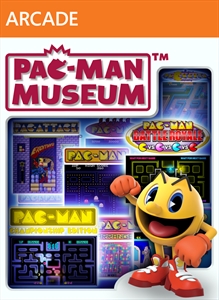 W
WPac-Man Museum is a compilation of Pac-Man games available on Xbox Live Arcade, PlayStation Network and Windows PC, and published by Bandai Namco Games under the Namco brand name. It was released on February 26, 2014, but was released on Steam and the North American PlayStation Store a day earlier. It was released in Japan for PS3 and Xbox 360 on June 25, 2014. A version was announced for the Nintendo eShop, to be released on Nintendo 3DS and Wii U, but was cancelled due to "delayed development". The game has been delisted from PlayStation and XBox since July of 2020.
 W
WPac-Man Party is a party game by Namco Bandai Games for the Wii and Nintendo 3DS. It is similar to the Mario Party series and Monopoly games for the Wii. In the game's story mode, players must retrieve a stolen cookie recipe from Pac-Man's enemies Blinky, Pinky, Inky, and Clyde by going to a location called Mirage Oasis and return the recipe to its rightful owner, Mr. Cookie.
 W
WPac-Man Pinball Advance is a pinball video game developed by Hungarian studio Human Soft and published by Namco for the Game Boy Advance. It was released in North America on May 2, 2005. It is part of the Pac-Man video game franchise.
 W
WPac-Man Vs. is a 2003 maze video game developed by Nintendo EAD and published by Namco for the GameCube. In the game, one player takes control of Pac-Man, who must eat all of the pellets in the maze, while the others control the ghosts to try to catch him. The objective is to be the first to reach a set number of points, selected before the game begins. The player controlling Pac-Man uses the Game Boy Advance to play, while the others use the television to control the ghosts. The game requires the GameCube - Game Boy Advance link cable in order to play.
 W
WPac-Man World: 20th Anniversary is a 1999 3D platform video game developed and published for the PlayStation by Namco. Controlling Pac-Man, the player must complete each of the game's six worlds, featuring five stages each, by collecting a certain amount of pellets to open up an exit door. The plot follows Pac-Man's enemies, the ghosts, crashing his 20th birthday and kidnapping his friends to bring them to their homeland of Ghost Island — with his birthday in ruins and his family in trouble, Pac-Man sets out to rescue them and defeat the ghosts.
 W
WPac-Man World 2 is a video game by Namco USA for Xbox, Nintendo GameCube, PlayStation 2, Game Boy Advance, and Microsoft Windows released in 2002. Like the original Pac-Man World, the player controls the character of Pac-Man in a 3D platforming game. The Game Boy Advance version is vastly different, with 2D characters moving in an isometric environment.
 W
WPac-Man World 3 is a platform video game developed by Namco Hometek and Blitz Games and published by Namco for the PlayStation 2, the GameCube, the Xbox, the PlayStation Portable, the Nintendo DS, and Microsoft Windows. The game was planned for release on Game Boy Advance, but this release is cancelled. The Nintendo DS version was ported by Human Soft. Released in 2005, it is the third installment in the Pac-Man World series and the only one in the series to not be released in Japan. It also features a speaking Pac-Man for the first time ever outside of the cartoon series.
 W
WPac-Man World Rally, known in Europe as Pac-Man Rally, is a kart racing game in the Pac-Man series. It was published by Bandai Namco Games, and released on August 22, 2006 for the PlayStation 2, Nintendo GameCube, PlayStation Portable, and Microsoft Windows. An Xbox version of the game was cancelled, though a preview of the game can be found in the Xbox release of Pac-Man World 3.
 W
WPac-Man: Adventures in Time is a Pac-Man game for the PC, developed by Mind's Eye Productions and Creative Asylum and Published by Hasbro Interactive in 2000. The game features five worlds, over forty 3D mazes, and Internet play.
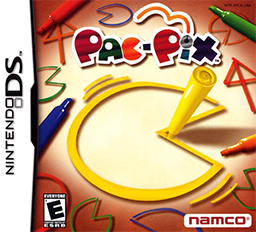 W
WPac-Pix (パックピクス) is a video game developed and published by Namco for the Nintendo DS. It stars Namco's popular video game mascot Pac-Man. The game makes extensive use of the system's touch screen, making the user draw Pac-Man and guide him through each level by drawing walls and devouring ghosts. Obstacles such as walls and shields must also be overcome by drawing bombs and arrows accordingly. Players also have control of the speed of the Pac-Man that they create, by changing the size of the drawing when it is created.
 W
WSpace Invaders is a Japanese shooting video game released in 1978 by Taito. It was developed by Tomohiro Nishikado, who was inspired by other media: Breakout, The War of the Worlds, and Star Wars. It is one of the forerunners of modern video gaming and helped expand the video game industry from a novelty to a global industry. It was first released as an arcade game and later remade on different platforms; re-releases include ported and updated versions. Ported versions generally feature different graphics and additional gameplay options, including moving defense bunkers, zigzag shots, invisible aliens, and two-player modes. Space Invaders is one of the highest-grossing video game franchises of all time.